Over Christmas my boyfriend bought some new plates, he wanted large platter type plates for the big day. I did think they were to be the food platters for serving the food from, but no they were to be used as dinner plates. This started me wondering about whether the size of the plate would mean that more food was eaten. The bigger plate was filled to capacity as is his way, he likes to feed everyone well, but that did mean that for me the meal was ¼ bigger than I would usually eat. I put it back, and the whippet had the best dinner of the year, but it was looking like I had confirmed my own thoughts that when faced with a bigger plate, the food portions just scaled up accordingly and we all ate more…
We all know that there has been a change in portion sizes, in particular with fast foods, at one stage they were getting bigger and bigger, we love a bargain let’s face it, and they know it.
After going through my cupboards and looking at the high number of dinner plates I’ve accumulated over the years. I found 2 which were significantly older and much smaller than the rest. In fact, it’s become called the kid’s plate, but this size of a plate would have been the norm about 40 years ago. Dinner plates were much smaller than our standard dinner plate now by about 2-3.5 inches. This is quite a difference for the amount of food that can be plated upon them and could be almost a second helping of food in some respects or about 30% more potentially being given. Depending on the food will depend on the calories intake difference.
In Europe the average is still about 9” in diameter, let’s go to the other extreme, that’s America of course where you can be faced with a plate of 13”. Studies have shown that if you are fed on a smaller plate you still feel full as though you have eaten from a bigger sized one interestingly.
There are many reasons why we are suffering from increasing levels of obesity, we are eating more and moving less, plates are a great visual way of showing us that we are potentially eating too much. Scaling them down could be a great way forward but also watching their colour is another one. Colour does impact on the way you see your food, the more it’s disguised against the plate colour the more you are likely to eat.
But size has also had an impact on wine glasses I think you will also agree. Well even if you don’t agree research shows that it’s increased 7 fold in 300 years. Beer and spirits were the tipple of choice for the majority until the 20th Century, wine was more favoured by those wealthier in our society. But from 1960’s wine drinking started to grow significantly as it became a more affordable drink. The change in wine glass size is considerable during this 300 year span from 66ml in the 1700’s to 417ml by the year 2000, to what is now 449ml. A considerable change I think you will agree. Back in 1746 there was a tax levied on glassware so that would have at that point kept the scale much smaller, and in the 1800’s glass production changed to more mass produced products. In the 1990’s the demand from America meant that glass sizes increased to accommodate them. The wine bars know that by increasing wine glass sizes they increase the volume of wine sold, it’s all about margins, and in England what used to be the norm of 125ml being served, has moved to 250ml which is ¼ of a bottle although we know that the glasses and servings are even bigger at times.
Size matters! It’s easy to fill out a plate that looks too empty when we don’t need that much food, and if we have larger glasses to fill them up. You might want to review those portion sizes which get lost against the bigger crockery.
References
http://www.bmj.com/content/359/bmj.j5623
